LINKSYS WUSB54GV2 Wireless-G USB Network Adapter User Manual Wusb54G ug Rev A
LINKSYS LLC Wireless-G USB Network Adapter Wusb54G ug Rev A
LINKSYS >
Contents
- 1. Users Manual Part 1
- 2. User Manual Part 2
- 3. Users Manual Part 3
Users Manual Part 1
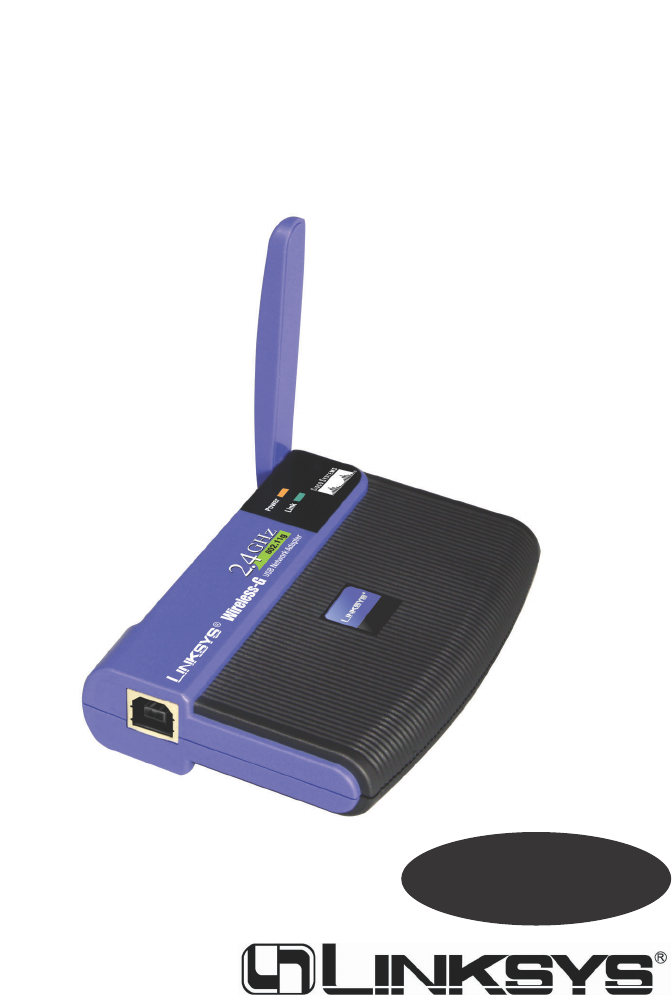
User Guide
Wireless-G USB
Network Adapter
Use this Guide to install: WUSB54G

COPYRIGHT & TRADEMARKS
Specifications are subject to change without notice. Linksys is a registered trademark or
trademark of Cisco Systems, Inc. and/or its affiliates in the U.S. and certain other coun-
tries. Copyright © 2003 Cisco Systems, Inc. All rights reserved. Other brands and prod-
uct names are trademarks or registered trademarks of their respective holders.
LIMITED WARRANTY
Linksys guarantees that every Wireless-G USB Network Adapter will be free from physi-
cal defects in material and workmanship for three years from the date of purchase, when
used within the limits set forth in the Specifications section of this User Guide. If the prod-
uct proves defective during this warranty period, call Linksys Technical Support in order
to obtain a Return Authorization number. BE SURE TO HAVE YOUR PROOF OF PUR-
CHASE ON HAND WHEN CALLING. When returning a product, mark the Return
Authorization number clearly on the outside of the package and include a copy of your
original proof of purchase. RETURN REQUESTS CANNOT BE PROCESSED WITHOUT
PROOF OF PURCHASE. All customers located outside of the United States of America
and Canada shall be held responsible for shipping and handling charges.
IN NO EVENT SHALL LINKSYS'S LIABILITY EXCEED THE PRICE PAID FOR THE PROD-
UCT FROM DIRECT, INDIRECT, SPECIAL, INCIDENTAL, OR CONSEQUENTIAL DAM-
AGES RESULTING FROM THE USE OF THE PRODUCT, ITS ACCOMPANYING SOFT-
WARE, OR ITS DOCUMENTATION. LINKSYS OFFERS NO REFUNDS FOR ITS PROD-
UCTS. Linksys makes no warranty or representation, expressed, implied, or statutory,
with respect to its products or the contents or use of this documentation and all accom-
panying software, and specifically disclaims its quality, performance, merchantability, or
fitness for any particular purpose. Linksys reserves the right to revise or update its prod-
ucts, software, or documentation without obligation to notify any individual or entity.
Please direct all inquiries to:
Linksys P.O. Box 18558, Irvine, CA 92623.
SAFETY AND REGULATORY NOTICES
FCC STATEMENT
The Wireless-G USB Network Adapter has been tested and found to comply with the
specifications for a Class B digital device, pursuant to Part 15 of the FCC Rules.
Operation is subject to the following two conditions:
(1) This device may not cause harmful interference, and
(2) This device must accept any interference received, including interference that may
cause undesired operation.
These limits are designed to provide reasonable protection against harmful interference
in a residential installation. This equipment generates, uses, and can radiate radio fre-
quency energy and, if not installed and used according to the instructions, may cause
harmful interference to radio communications. However, there is no guarantee that inter-
ference will not occur in a particular installation. If this equipment does cause harmful
interference to radio or television reception, which is found by turning the equipment off
and on, the user is encouraged to try to correct the interference by one or more of the
following measures:
• Reorient or relocate the receiving antenna
• Increase the separation between the equipment or devices
• Connect the equipment to an outlet other than the receiver's
• Consult a dealer or an experienced radio/TV technician for assistance
FCC Caution: Any change or modification to the product not expressly approved by
Linksys could void the user's authority to operate the device.
FCC RF Radiation Exposure Statement
To comply with the FCC and ANSI C95.1 RF exposure limits, the antenna(s) for this
device must comply with the following:
• Access points with 2.4 GHz or 5 GHz integrated antenna must operate with a sepa-
ration distance of at least 20 cm from all persons using the cable provided and must
not be co-located or operating in conjunction with any other antenna or transmitter.
End-users must be provided with specific operations for satisfying RF exposure compli-
ance.
Note: Dual antennas used for diversity operation are not considered co-located.
Canadian Department of Communications Industry Canada (IC) Notice
This Class B digital apparatus complies with Canadian ICES-003 and RSS-210.
Cet appareil numérique de la classe B est conforme à la norme NMB-003 et CNR-210
du Canada.
"To prevent radio interference to the licensed service, this device is intended to be oper-
ated indoors and away from windows to provide maximum shielding. Equipment (or its
transmit antenna) that is installed outdoors is subject to licensing."
" Pour empêcher que cet appareil cause du brouillage au service faisant l'objet d'une
licence, il doit être utilisé à l'intérieur et devrait être placé loin des fenêtres afin de fournir
un écran de blindage maximal. Si le matériel (ou son antenne d'émission) est installé à
l'extérieur, il doit faire l'objet d'une licence. "
EC DECLARATION OF CONFORMITY (EUROPE)
Linksys Group declares that the Instant Wireless®Series products included in the Instant
Wireless®Series conform to the specifications listed below, following the provisions of the
European R&TTE directive 1999/5/EC, EMC directive 89/336/EEC, and Low Voltage
directive 73/23/EEC:
For 2.4 GHz devices with 100 mW radios, the following standards were applied:
• ETS 300-826, 301 489-1 General EMC requirements for Radio equipment.
• EN 609 50 Safety
• ETS 300-328-2 Technical requirements for Radio equipment.
Caution: This equipment is intended to be used in all EU and EFTA countries. Outdoor
use may be restricted to certain frequencies and/or may require a license for operation.
Contact local Authority for procedure to follow.

Note: Combinations of power levels and antennas resulting in a radiated power level of
above 100 mW equivalent isotropic radiated power (EIRP) are considered as not com-
pliant with the above mentioned directive and are not allowed for use within the European
community and countries that have adopted the European R&TTE directive 1999/5/EC
and/or the CEPT recommendation Rec 70.03.
For more details on legal combinations of power levels and antennas, contact Linksys
Corporate Compliance.
• Linksys Group vakuuttaa täten että Wireless-G USB Network Adapter tyyppinen laite
on direktiivin 1999/5/EY, direktiivin 89/336/EEC ja direktiivin 73/23/EEC oleellisten
vaatimusten ja sitä koskevien näiden direktiivien muiden ehtojen mukainen.
• Linksys Group déclare que la Wireless-G USB Network Adapter est conforme aux
conditions essentielles et aux dispositions relatives à la directive 1999/5/EC, la direc-
tive 89/336/EEC, et à la directive 73/23/EEC.
• Belgique B L'utilisation en extérieur est autorisé sur le canal 11 (2462 MHz), 12 (2467
MHz), et 13 (2472 MHz). Dans le cas d'une utilisation privée, à l'extérieur d'un bâti-
ment, au-dessus d'un espace public, aucun enregistrement n'est nécessaire pour
une distance de moins de 300m. Pour une distance supérieure à 300m un enreg-
istrement auprès de l'IBPT est requise. Pour une utilisation publique à l'extérieur de
bâtiments, une licence de l'IBPT est requise. Pour les enregistrements et licences,
veuillez contacter l'IBPT.
• France F:
2.4 GHz Bande : les canaux 10, 11, 12, 13 (2457, 2462, 2467, et 2472 MHz respec-
tivement) sont complétement libres d'utilisation en France (en utilisation intérieur).
Pour ce qui est des autres canaux, ils peuvent être soumis à autorisation selon le
départment. L'utilisation en extérieur est soumis à autorisation préalable et très
restreint.
2.4 GHz Band: only channels 10, 11, 12, 13 (2457, 2462, 2467, and 2472 MHz
respectively) may be used freely in France for indoor use. License required for out-
door installations.
• Deutschland D: Anmeldung im Outdoor-Bereich notwending, aber nicht genehmi-
gungspflichtig. Bitte mit Händler die Vorgehensweise abstimmen.
• Germany D: License required for outdoor installations. Check with reseller for proce-
dure to follow.
• Italia I: E' necessaria la concessione ministeriale anche per l'uso interno. Verificare
con i rivenditori la procedura da seguire. L'uso per installazione in esterni non e' per-
messa.
• Italy I: License required for indoor use. Use with outdoor installations not allowed.
• The Netherlands NL License required for outdoor installations. Check with reseller for
procedure to follow.
• Nederlands NL Licentie verplicht voor gebruik met buitenantennes. Neem contact op
met verkoper voor juiste procedure.
WUSB54G-UG-3015A KL
Table of Contents
Chapter 1: Introduction 1
The Wireless-G USB Network Adapter 1
Features 1
Chapter 2: Planning Your Wireless Network 2
Network Topology 2
Ad-Hoc versus Infrastructure Mode 2
Chapter 3: Getting to Know the
Wireless-G USB Network Adapter 4
The Adapter’s Ports 4
The Adapter’s LEDs 4
Chapter 4: Software Installation
and Configuration for Windows 2000 5
Chapter 5: Hardware Installation 9
Connecting the Adapter 9
Chapter 6: Driver Installation for Windows XP 11
Windows XP Wireless Zero Configuration 12
Chapter 7: Using the WLAN Monitor 14
Overview 14
Accessing the WLAN Monitor 14
Link Information 15
Site Survey 17
Profiles 18
Creating a New Profile 20

1
Chapter 1: Introduction
Connect your USB-equipped desktop or notebook computer to a wireless net-
work at incredible speeds with the Linksys Wireless-G USB Network Adapter.
By incorporating two new, blazing fast technologies -- USB 2.0 and Wireless-
G -- the Adapter delivers data rates up to 54Mbps (5 times as fast as 802.11b),
without the trouble of opening up the case of your desktop computer.
To install, simply plug the Adapter into any available USB port. (It's compati-
ble with both USB 1.1 and 2.0 ports, but 2.0 will yield the fastest speeds.) It
gets its power through the USB connection, so no power cord is necessary. The
included Setup Wizard walks you through configuring the Adapter to your
wireless network settings, step by step. The Wireless-G USB Network Adapter
is also compatible with the Wireless-B (802.11b) network standard, with data
rates up to 11Mbps. And your wireless communications can be protected by
128-bit encryption, so your data stays secure.
The Wireless-G USB Network Adapter's high-gain antenna lets you put your
computer almost anywhere in the building, without the cost and hassle of run-
ning cables. Now you don't have to drill holes in your walls and climb through
the attic or cellar to get connected to the network. Once you're connected, you
can keep in touch with your e-mail, access the Internet, use instant messaging
to chat with friends, and share files and other resources such as printers and
hard disk storage space with other computers on the network.
So don't hassle with running cables through your house -- get connected the
easy way with the Wireless-G USB Network Adapter.
• Compatible with 802.11g and 802.11b (2.4GHz) Stardards
• Support USB 2.0 with up to 54Mbps, High-Speed Data Transfer Rate with
Automatic Fallback
• Plug-and-Play Operation Provides Easy Setup
• Supports up to 128-bit WEP Encryption Security
• Compatible with Microsoft Windows 2000 and XP
Appendix A: Troubleshooting 26
Common Problems and Solutions 26
Frequently Asked Questions 27
Appendix B: Glossary 30
Appendix C: Specifications 38
Environmental 39
Appendix D: Warranty Information 40
Appendix E: Contact Information 41
The Wireless-G USB Network Adapter
Features
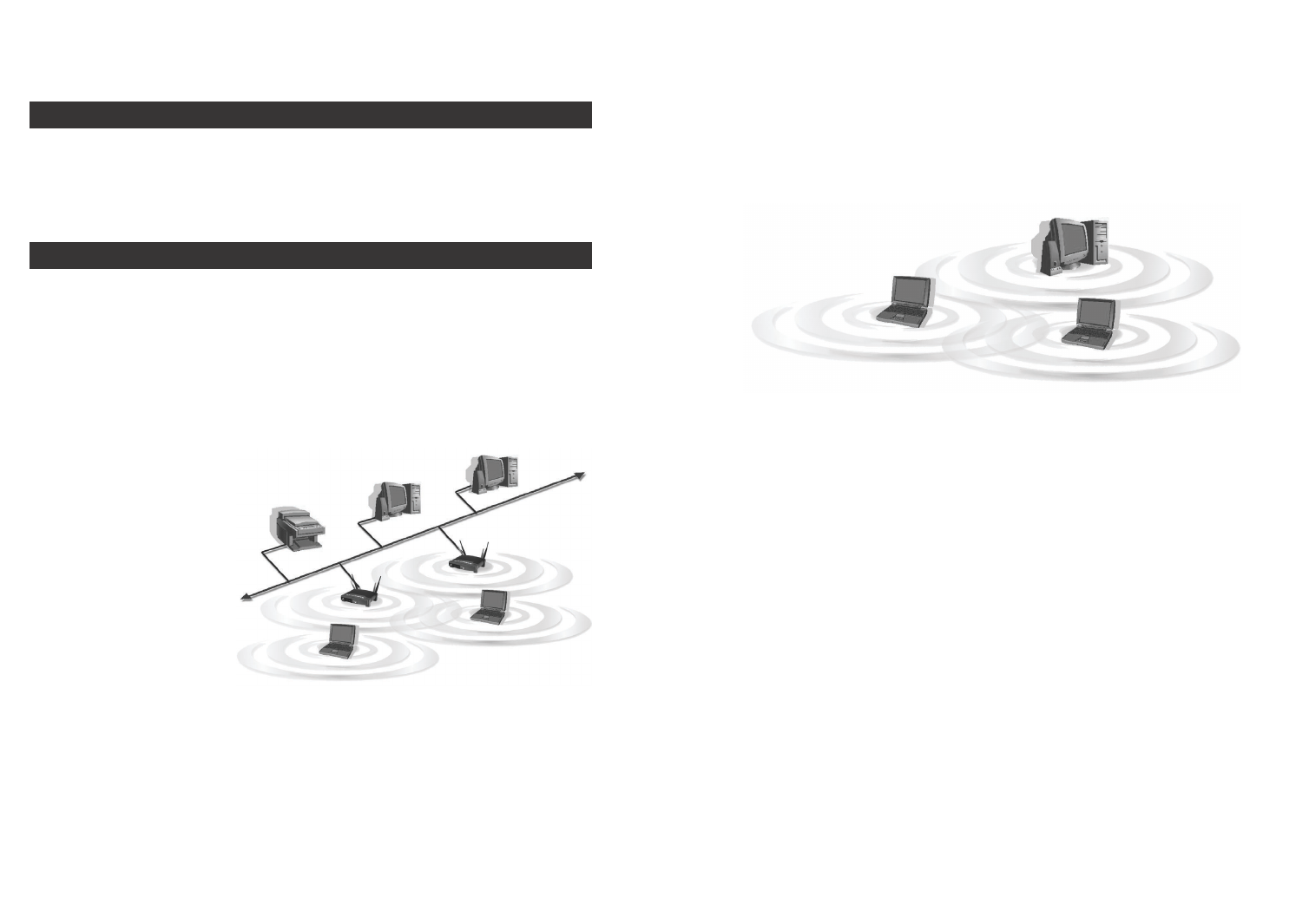
If the wireless network is relatively small and needs to share resources only
with the other computers on the wireless network, then the ad-hoc mode can
be used. (See Figure 2-2.) Ad-hoc mode allows computers equipped with wire-
less transmitters and receivers to communicate directly with each other, elimi-
nating the need for an access point. The drawback of this mode is that, in Ad-
Hoc mode, wireless-equipped computers are not able to communicate with
computers on a wired network. And, of course, communication between the
wireless-equipped computers is limited by the distance and interference direct-
ly between them.
32
Figure 2-2
Chapter 2: Planning Your Wireless
Network
A wireless local area network (WLAN) is exactly like a regular local area net-
work (LAN), except that each computer in the WLAN uses a wireless device to
connect to the network. Computers in a WLAN share the same frequency
channel and SSID, which is an identification name for wireless devices.
Unlike wired networks, wireless networks have two different modes in which
they may be set up: infrastructure and ad-hoc. An infrastructure configura-
tion is a WLAN and wired LAN communicating to each other through an
access point. An ad-hoc configuration is wireless-equipped computers com-
municating directly with each other. Choosing between these two modes
depends on whether or not the wireless network needs to share data or periph-
erals with a wired network or not.
If the computers on the
wireless network need to
be accessed by a wired
network or need to share a
peripheral, such as a print-
er, with the wired network
computers, the wireless
network should be set up
in infrastructure mode.
(See Figure 2-1.) The
basis of infrastructure
mode centers around an
access point, which serves
as the main point of communications in a wireless network. Access points
transmit data to PCs equipped with wireless network cards, which can roam
within a certain radial range of the access point. Multiple access points can be
arranged to work in succession to extend the roaming range, and can be set up
to communicate with your Ethernet (wired) hardware as well.
Network Topology
Ad-Hoc versus Infrastructure Mode
Figure 2-1
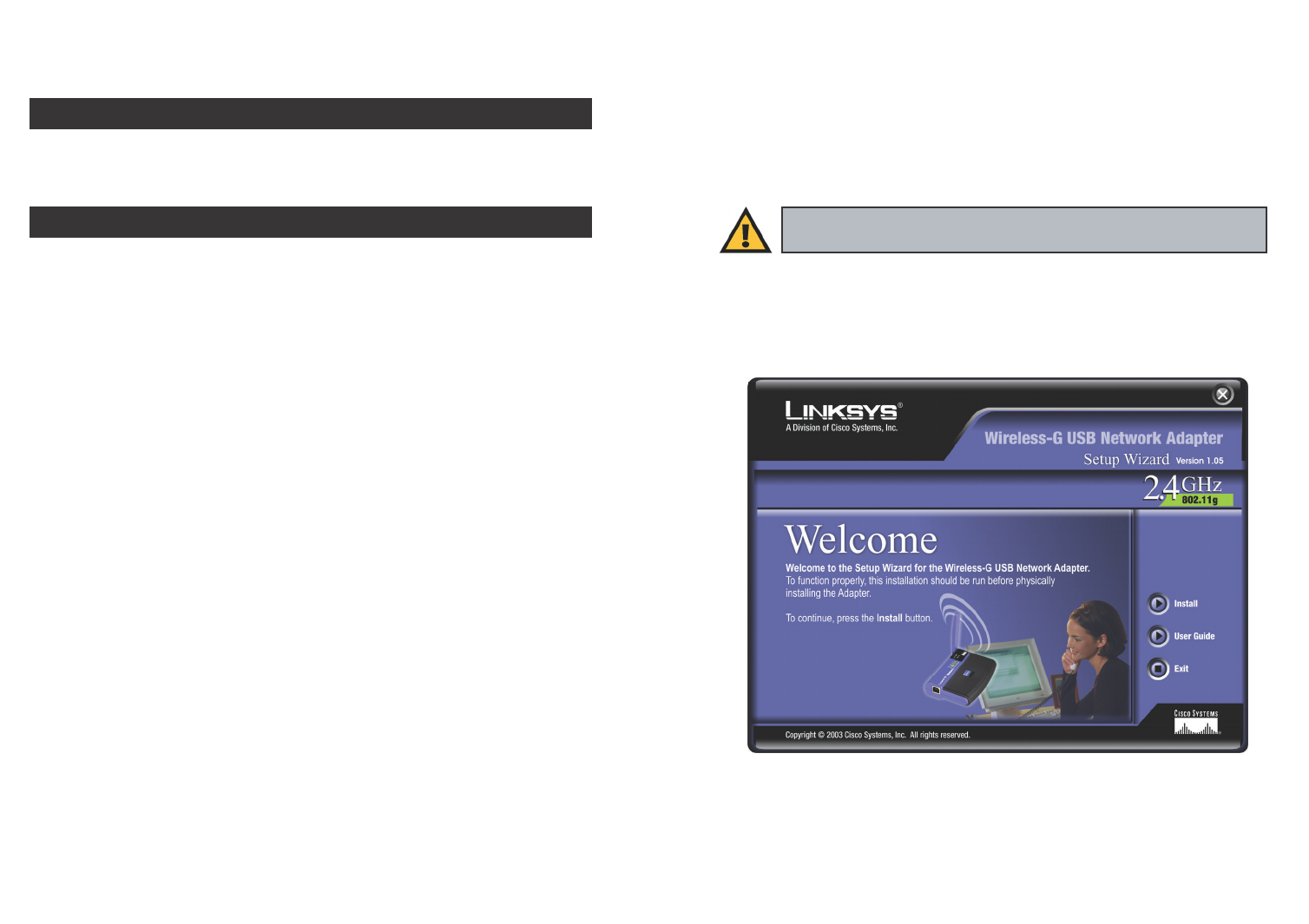
5
Chapter 4: Software Installation and
Configuration for Windows 2000
The Wireless-G USB Network Adapter Setup Wizard will guide you through
the installation procedure. The Setup Wizard will install the WLAN Monitor
and driver, as well as configure the Adapter.
1. Insert the Setup Wizard CD-ROM into your CD-ROM drive. The Setup
Wizard should run automatically, and Figure 4-1 should appear. If it does
not, click the Start button and choose Run. In the field that appears, enter
D:\setup.exe (if “D” is the letter of your CD-ROM drive).
To install the Adapter, click the Install button on the Welcome screen. Click
User Guide to view this User Guide or click Exit to exit the Setup Wizard.
Figure 4-1
Important: You must run the Setup Wizard to install the software
before connecting the Adapter.
4
Chapter 3: Getting to Know the
Wireless-G USB Network Adapter
The Network Adapter is connected to your PC through its USB port. All power
is provided through the USB connection, making a power adapter unnecessary.
The Network Adapter’s LEDs show you how the Adapter is functioning.
Power Green. This LED will light up to let you know that the Adapter is
adequately powered over the USB connection.
Link Green. The Link LED will be lit steadily when the Network
Adapter is connected to your wireless network. The LED will
blink when there is wireless network traffic.
The USB Port
The Adapter’s LEDs
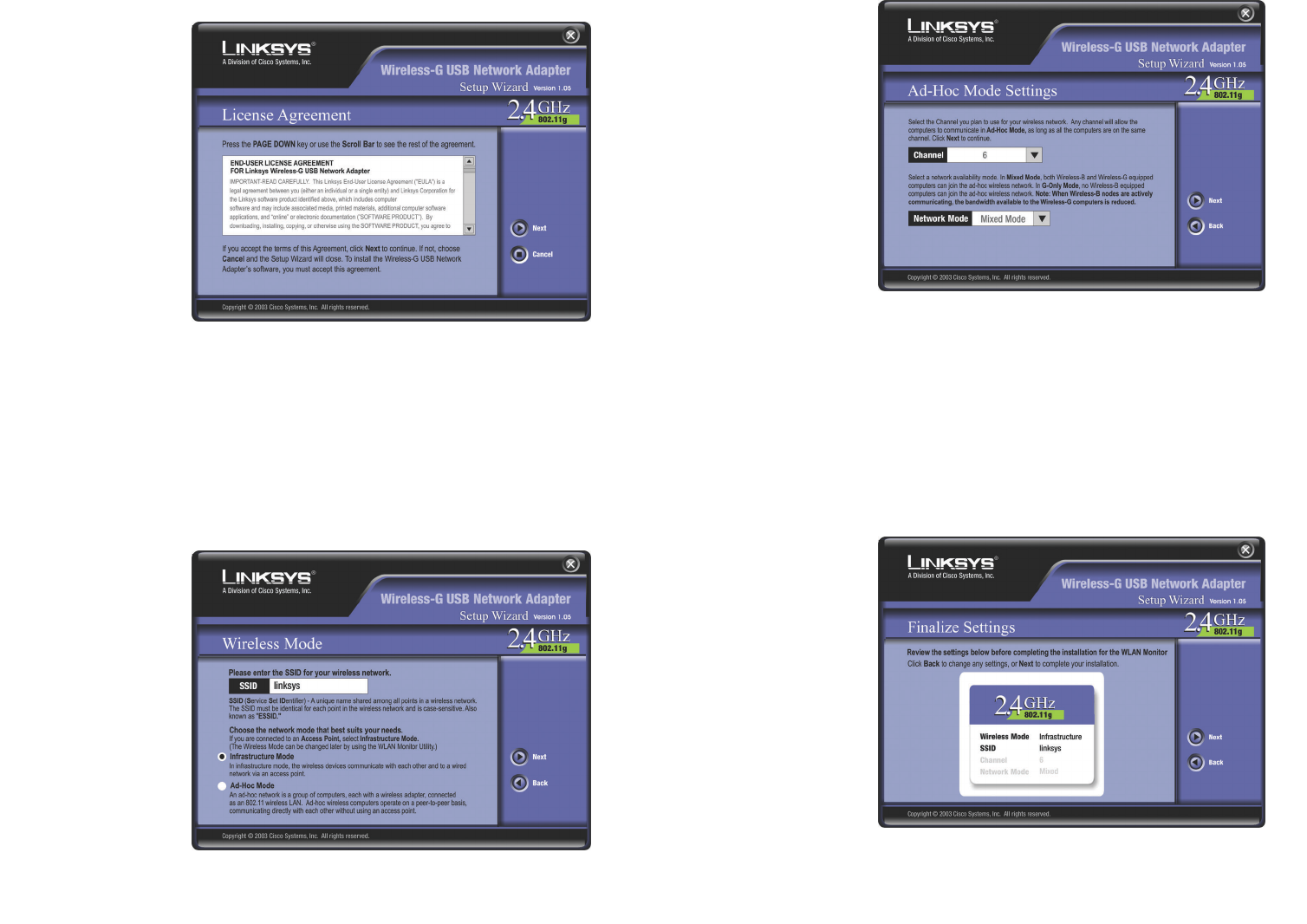
76
4. If you chose
Infrastructure
Mode, go to Step
5now. If you
chose Ad-Hoc
Mode, select the
correct operating
channel for your
network from the
Channel drop-
down menu.
Then, select the
Network Mode
from the drop-
down menu.
Click the Next
button, and go to Step 5. Click the Back button to change any settings.
Channel - The channel you choose should match the channel set on the
other devices in your wireless network. If you are unsure about which chan-
nel to use, select the default channel (Channel 6).
Network Mode - Keep the default setting, Mixed, if you have Wireless-G
and Wireless-B devices in your network. Select G-Only if you have only
Wireless-G devices in your network.
5. The Setup Wizard
will ask you to
review your set-
tings before it
starts to copy
files. Click the
Next button to
save these set-
tings, or click the
Back button to
change any set-
tings.
Figure 4-4
Figure 4-5
2. Read the License Agreement and click the Next button to continue the
installation. If
you click the
Cancel button,
you will end the
installation.
3. The following screen, shown in Figure 4-3, will ask for some information
about your wireless network. In the SSID field, enter your network’s SSID
(Service Set Identifier). The SSID is your network name and must be iden-
tical for all devices in the network. The default setting is linksys (all low-
ercase).
Next, choose a wireless mode. Click the Infrastructure Mode radio button
if you want your wireless computers to network with computers on your
wired network using a wireless access point. Click the Ad-Hoc Mode radio
button if you
want multiple
wireless com-
puters to net-
work directly
with each other.
Click the Next
button to contin-
ue, or click the
Back button to
return to the
previous page.
Figure 4-2
Figure 4-3
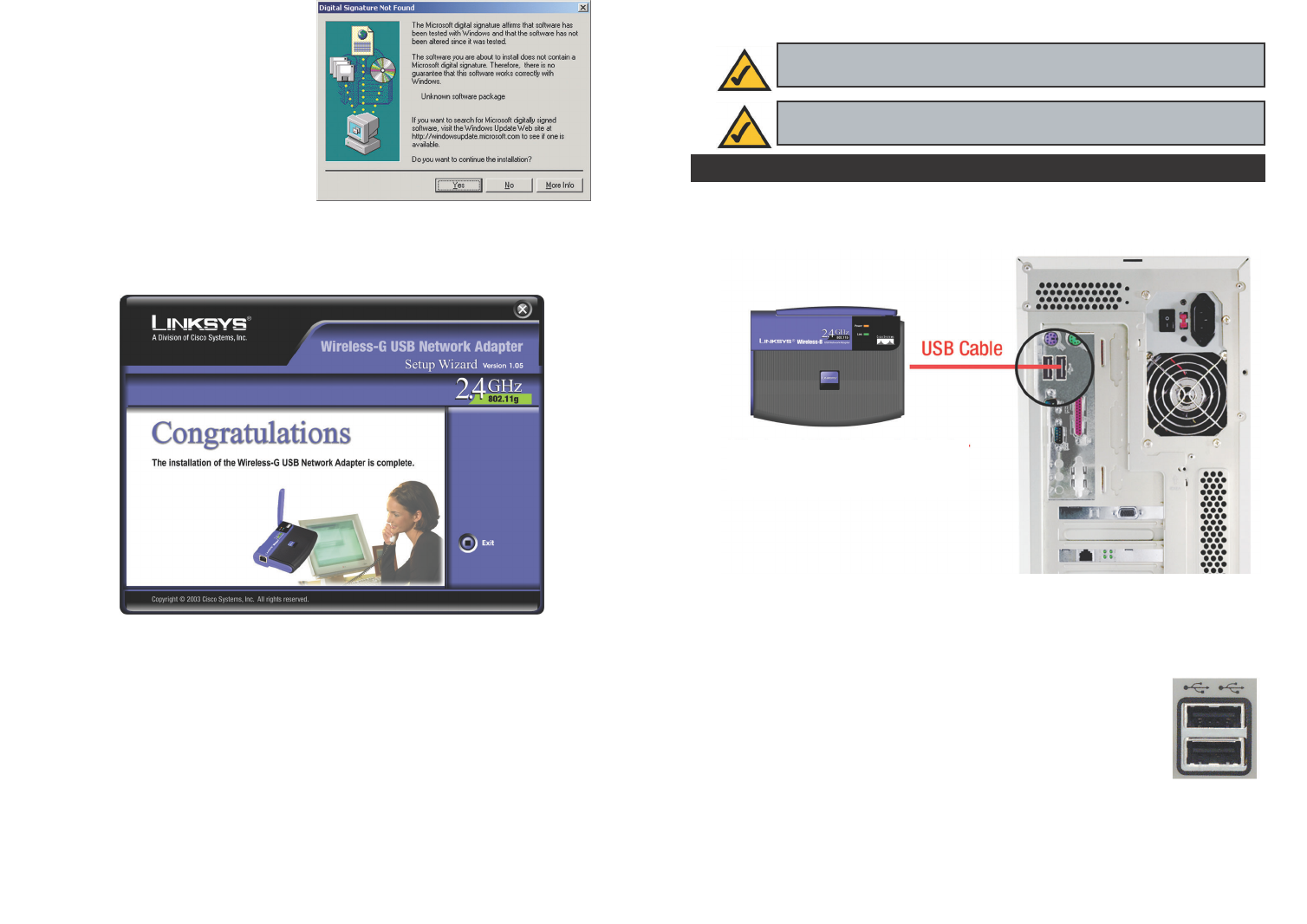
98
6. At this point, you may see a warn-
ing screen, such as that shown in
Figure 4-6 , asking if you’d like to
cease installation. You can click
the Yes button to continue; the
Adapter will function properly.
7. After the files have been successfully copied, the screen in Figure 4-7 will
appear. Click the Exit button.
Proceed to “Chapter 5: Hardware Installation.”
Figure 4-6
Figure 4-7
Chapter 5: Hardware Installation
1. The Adapter comes with the USB cable you will use to connect the Adapter
to your PC. (See Figure 5-1.)
2. Connect one end of the USB cable to the USB port of the Adapter.
3. Connect the other end of the USB cable to one of the USB
ports on your computer (see Figure 5-2).
Figure 5-1
Figure 5-2
Connecting the Adapter
Wireless-G USB
Network Adapter
Important for Windows 2000 users: You must run the Setup Wizard
to install the software before installing the hardware.
Important for Windows XP users: You must install the Adapter’s
hardware before installing the software.